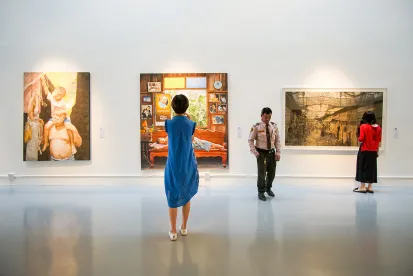The Supreme Court recently upheld an appellate court’s ruling that Andy Warhol’s use of a photograph of Prince as a reference for a collection of screen prints is not fair use – to the extent his foundation decided to license them at least. In the weeks that followed, the Supreme Court’s decision in Andy Warhol Foundation for the Visual Arts, Inc. v. Goldsmith et al, Case No. 21-869, has been met by both praise and scorn, but we think the holding provides some useful guidance to visual artists to avoid running foul of rights holders– even if it does leave many questions unanswered.
The main principle practitioners can derive from Goldsmith is that transformation alone is not enough render copying of a reference work “fair use.” Although Justice Kagan disagreed in a fiery dissent, we think Justice Sotomayor’s opinion helps to bring some logical clarity to an area that has been repeatedly misconstrued by the courts. Of course, like many creators, we might have hoped for a ruling that would give artists greater leeway to use pre-existing works freely, but as attorneys, we believe that Goldsmith is consistent with both precedent and the spirit of the Copyright Act.
At issue in Goldsmith was whether Andy Warhol’s creation of a series of colorful screen prints of musician Prince from an unlicensed black and white photo was fair use. The photographer Lynn Goldsmith had licensed the photo to Vanity Fair in 1984 for $400 to use as a reference for an Andy Warhol cover illustration “one time only.” Unbeknownst to Ms. Goldsmith, Andy Warhol not only used Ms. Goldsmith’s photo to create an illustration for Vanity Fair, he created an entire “Prince Series” of screen prints. When Prince passed away in 2016, the Andy Warhol Foundation (“AWF”) licensed “Orange Prince” for use on the cover of a commemorative magazine cover.

The only issue before the Court was whether Warhol’s admitted copying of Goldsmith’s original and licensing of the Warhol adaption of it for use as a magazine cover was protected by fair use, specifically, whether the “purpose and character” of Warhol’s use supported a finding of fair use.
Judge Sotormayor’s opinion for the Court’s 7-2 majority focused on the meaning of the first fair use factor in Section 107 of the Copyright Act, i.e., “(1) the purpose and character of the use, including whether such use is of a commercial nature or is for nonprofit educational purposes.” The Court recognized that the “purpose and character” of some copying could be “transformative” and thus could favor a finding of fair use. What is or is not “transformative,” however, is largely framed by the original author’s statutory right to control derivative works, i.e., a new work of authorship that is created by modifying, transforming or adapting the original in some way. Plainly the Warhol “Orange Prince” was a derivative work, but was there something about it that could support a finding of fair use?
The district court below had found that Orange Prince was a “transformative” use because Orange Prince had, in the court’s view, a “different character” than the original and employing “new aesthetics with creative and communicative results distinct from Goldsmith’s.” Relying on expert testimony, the district court reasoned that Orange Prince could “reasonably be perceived to have transformed Prince from a vulnerable, uncomfortable person to an iconic, larger-than-life figure.” This opinion was roundly criticized as putting federal district judges in the position of art critics to determine how to interpret the meaning of an artist’s additions to a pre-existing work.
Both the Second Circuit and now the Supreme agreed, holding that a different artistic message, standing alone, would be insufficient to support a finding of fair use. The Court noted that plainly an adaptation of a novel or a remix of a pop song might send a different artistic message than the original – but that would not give a copyist a free pass to use the original to make a new or different artistic expression since that is a right that is exclusive to the copyright owner.
To be considered a transformative fair use, the purpose of the use “must go beyond that required to qualify as derivative” and must independently “serve copyright’s goal of enriching public knowledge” in a way different from the original. For example, a parody of a popular song is a commentary on the song itself. Thus, the purpose of the parody is different from the original. The Court pointed to Warhol’s famous Campbell’s soup series as another example, i.e., Warhol’s commentary on consumerism as reflected in the Campbell’s soup label. Recognizing that there is no bright line that separates a transformative use from one that is not, the Court held that uses that share the same commercial purpose are far less likely to be fair use. If there is no “independent justification” for copying (apart from simply for the love of art), the fair use defense will likely fail under the Court’s reasoning.
To determine whether a use is transformative, the Court held that district courts should analyze the specific use alleged to infringe — here the licensing of a picture of Prince for use in connection with articles about him. The Court reasoned that the uses of a photographer’s work—over which they should exercise control—include licensing the work as a reference work for other artists and licensing the work for use in connection with magazine content, the same uses at issue here. Because the essential purpose of AWF’s use was the same, there was no independent justification for copying Goldsmith’s work.
The dissent authored by Justice Kagan and joined by Chief Justice Roberts focused primarily on the fact that Andy Warhol had made significant contributions to Orange Prince such that it was a significant piece of art in its own right. The majority, however, rejected the idea that a famous artist enjoys a privilege under copyright law to make derivative works just because a judge or a jury might find that artist’s contributions to be meaningful or profound.
While the dissent found support from precedent, taken to its logical conclusion, it made no sense. For example, would a famous director be entitled to copy the plot of a novel because she brings a new or different artistic message to the underlying content? The mere fact that a subsequent artist may (or may not) bring some profound new meaning to an old work should not deprive the original author of her right to control derivative works.
Because the only issue for decision was whether the licensing of the photo as a magazine cover constituted infringement, the Court reached no opinion on whether Warhol’s act of painting the Prince Series, displaying it or selling the individual works were protected by fair use. Thus, it remains to be seen whether creating a piece of derivative artwork would be considered fair use while licensing in competition with underlying work’s author would be infringing.
Several commentators have expressed dismay that Goldsmith will chill artistic expression, which is undoubtedly true – but that is beside the point and does not mean that the Court majority was wrong. The effect that Goldsmith would have on the ability of, for example, a collage artist to use pre-existing works is speculative at best – especially considering that such a work might not infringe to begin with. And of course, to the extent that use of the underlying work is necessary to make a point about the underlying work itself (as was the case in the Supreme Court’s seminal decision in Campbell v. Acuff-Rose Music, Inc., 510 U.S. 569, 579 (1994)) that will clearly be fair use.
Numerous stories in the press have speculated as to how Goldsmith will impact the ongoing litigation over the scraping of images by artificial intelligence software to create new images. When considering those cases, one has to consider the purpose of the copying, which the defendants will argue is simply to analyze the underlying works, not to create competitive derivative works. Were such an AI application used to create actual copies or derivatives of specific copyrighted works that were used to compete in the same market as the originals, then this would fit nicely within Goldsmith’s analysis. At this point, this speculation seems a little premature.




 />i
/>i

